

 The South African
The South African
by Major DD Hall
Part I in this series on artillery ammunition appeared in Journal Volume 3 No 4, December 1975. In that article the ammunition of the 15 pr was discussed. It is appropriate that this article should be devoted to the ammunition of the 9 pr, as this gun also, is prominent in the artillery history of South Africa.
When the Royal Artillery reverted to muzzle-loading in 1871, the 9 pr 8 cwt RML, (rifled muzzle-loader) was the gun selected for field artillery use. In 1874, a 9 pr 6 cwt was introduced for horse artillery, and this gun was later adopted for field artillery use as well - the 8 cwt version being withdrawn from service. All patterns were rifled in the same way, and ammunition was interchangeable.
The 9 pr remained the principal field gun in service with the Royal Artillery until 1878 when a 13 pr 8 cwt RML was introduced. A 12 pr 7 cwt marked the return to breech-loading in 1883, and the well-known 15 pr 7 cwt BL appeared in 1895.
In the context of colonial wars, the 9 pr was the field gun from 1870 to 1895, and the 15 pr from then until the arrival of the 18 pr in 1906. The 9 pr was, therefore, the gun of the Zulu War of 1879, and the First Boer War of 1881. It must be remembered that other equipments were also used in these wars — notably 7 prs, Gatlings and rockets — but the 9 pr was the main field artillery weapon of the Royal Artillery at this time.
The 9 pr fired shrapnel, case shot and common shell.
The article consists of the following parts:
A major difference between 9 pr and 15 pr ammunition related to the method of shell rotation. Both guns were rifled, but the rifling was very different. 15 pr rifling was multigrooved. On the gun being fired, the rifling cut into a soft copper driving band around the base of the shell, and the twist of the rifling imparted spin to the shell.
The 9 pr was muzzle-loading, and thus the shell could not be forced down the barrel against a rifling system of the 15 pr type. The answer was to have only three rifling grooves, and for the shell to have corresponding projecting metal studs on its outer casing. The shell turned in the grooves as it was rammed home, and these grooves then imparted spin to it when it was fired.
The 9 pr was loaded by ramming from the muzzle end, first the propellant charge, and then the shell. To fire the gun, it was necessary to ignite the charge.
In early days, gunpowder was poured into the vent, a flame was applied, and the resulting explosion ejected the projectile. For better results, in 1765 gunpowder was inserted into the vent in a tin tube. Later a goose quill replaced the tin tube. As the burning time of this gunpowder could vary, a better method was looked for.
At the end of the 18th Century, a flintlock firing mechanism was introduced. This was first used by the Royal Navy who needed the assurance that, in a rolling ship, the moment of firing would come exactly when it was wanted. This method was later applied to Land Service guns.
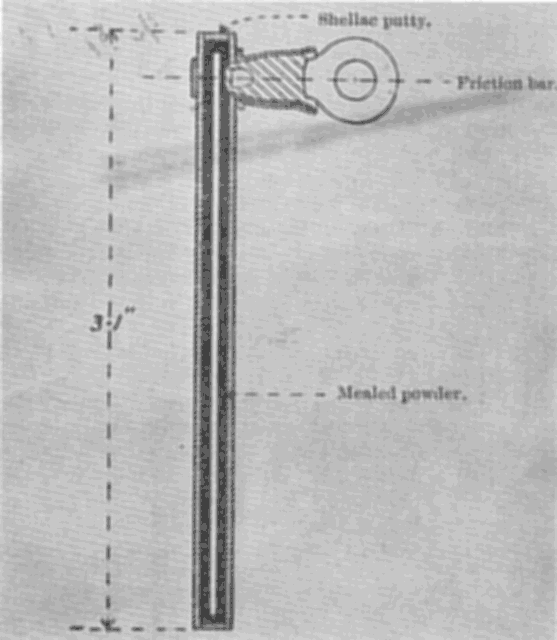
In 1841, friction tubes were invented by an officer in the Hanoverian Artillery. As their action was instantaneous and they were simpler and easier to operate than the flintlock system, they remained in service (with variations) until the introduction of the 18 pr. The 9 pr RML friction tube was made of sheet copper and was 7,8 cm (3,1 in) long. It was filled with mealed powder. The top was closed with shellac putty and varnished paper, the bottom by a disc of varnished paper. A short piece of tubing was attached to the top. This was called the nib-piece. Inside this was a copper friction bar which was roughened on both sides and smeared with detonating composition. The exterior of the tube was varnished black. The friction tube was placed in the vent with a lanyard attached to the friction bar, after the gun was loaded. When the lanyard was pulled sharply, the detonating composition exploded, igniting the mealed powder from which the flame struck the cartridge.
The full, or service charge, was 0,8 kg (1,75 lb) of RLG (Rifle Large Grain) powder. Gunpowder had changed little since its first introduction. With the introduction of the Armstrong RBL (rifled breech-loader) guns in the 1860s, it was decided to provide a powder which burnt more slowly than the fine grain powder then in use. RLG powder was introduced. This was basically the same powder but formed into large grains which slowed the rate of burning. This caused the powder to develop its power gradually as the shell cut into the rifling of the bore. This RLG powder was used with the 9 pr RML gun, although the resistance of the rifling in the three groove system was less than that of the earlier multigroove RBL system. The charge was supplied in a cylindrical bag of wool serge. The bottom was flat and the top gathered and sewn. It was held in shape by bands of blue worsted braid. Charge bags were printed with black letters, showing the mark, nature of the gun and the weight of the charge. The charge exploded on being ignited by the flash from the friction tube, propelling the shell forward at 420 m/sec (1 380 ft/sec) and producing a dense cloud of white smoke.
This fuze consisted of a truncated cone of beech wood, about 7,6 cm (3 in) long. Bored down its length were three powder channels, one central, A, and two parallel to it, B - (only one channel B is shown in the section diagram). Side holes, C, were marked with odd and even numbers representing the half seconds of the fuze’s burning time. They were covered externally by varnished paper. A quick match, D, was connected to a copper pin, F, at the top of the central channel. A Plug, F, at the head of the fuze, prevented it from being extinguished in flight, or on impact, if still burning then. The whole was protected by a strip of varnished paper, H.
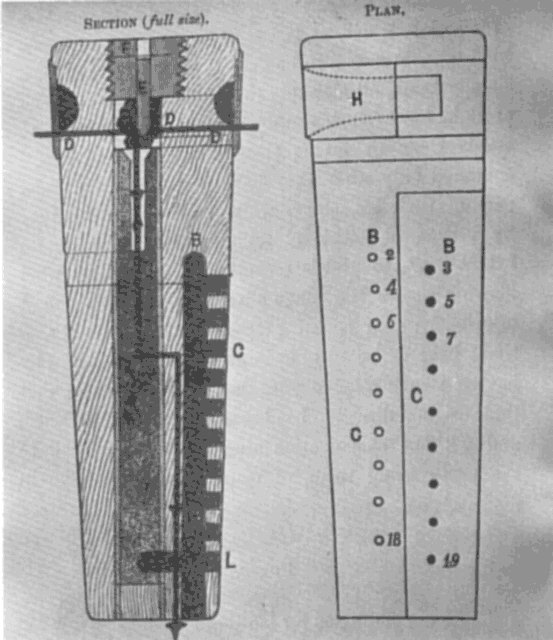
To prepare a fuze for use, a gimlet was forced through a side hole, C, corresponding to the number of seconds for the estimated range. The metal plug was then unscrewed from the shell, and the fuze driven into the fuze opening with two or three sharp taps from a mallet. The paper band, H, was then torn off, exposing the ends of the quick match. On firing, the flash from the cartridge rushed over the sides of the shell, igniting the ends of the quick match. This quickly ignited the central channel which burned at the rate of 2,5 cm (1 in) in five seconds. On reaching the hole, C, through which the gimlet had been inserted, the flame burst into the powder channel, B, and fired the powder in it. This flashed downwards, igniting the bursting charge and exploding the shell. Should the gimlet not have pierced the side hole correctly, the ultimate explosion of the shell was assured by a piece of quick match, L, which connected the central channel with the bottom hole of each channel, B. If the shell hit the ground before the fuze had operated, the impact drove the fuze into the shell’s bursting charge, exploding it and thus acting as a percussion fuze. The fuze was painted black.
It was invented by Colonel E.M. Boxer and so was known as a Boxer fuze. Similar to its predecessors, it was more accurate and easier to set. Several hundred thousand were produced at Woolwich, but unfortunately they were found to be unreliable in service. Apparently the wood-turning machines used to make the fuze bodies were too well lubricated, and some of the oil found its way into the wood, eventually affecting the powder filling, and causing irregular burning. This point should be borne in mind when reading the comments on time and percussion fuzes in Part 4 which follows.
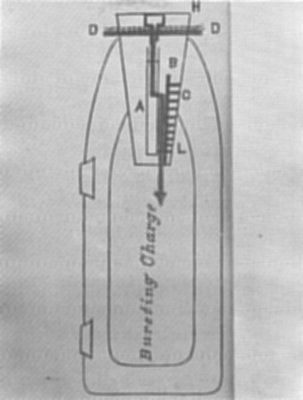
This fuze was normally used with common shell. Although the Boxer time fuze was also designed to have a percussion effect as described above, it was not normally thought of in this connection. The body of the 9 pr’s percussion fuze was made of gun metal. Inside the top plate, a small needle, A, was fixed pointing downwards. A metal collar, B, fitted inside the fuze, held in position by a safety pin, C, which ran through it. A lead pellet, U, fitted inside the metal collar, B. In the top of this was a detonating cap, F. Below this was the powder, H, pressed into a hard cake with a space, K, down the centre. The safety pin, C, prevented accidental explosion, by keeping the detonating cap, F, away from the needle, A. As the flash of the gun was liable to ignite the fuze through the withdrawn pin-hole, a pellet, L, was placed so that it dropped over the aperture as soon as the safety pin was removed. When required for use, the fuze was screwed into the head of the shell and the safety pin pulled out by the tape, O. On the shock of discharge, the metal collar, B, was set back, or downwards, crushing the four metal ‘feathers’ projecting from the lead pellet, U (two are shown above the letters, F, in the diagram). On impact, the metal collar, B, and the pellet, U, flew forward - the lead pellet, E came into contact with the needle, A, and exploded the fuze. The thin plate, N, was driven out and the bursting-charge ignited.

A Special Committee of 1875 reported that this was ‘the safest and most efficient percussion fuze for field service with which the committee was acquainted’. It is of interest to digress at this point, and to discuss the two fuzes just described. The first line holdings of each 9 pr were 120 time and 96 percussion fuzes. Writing in ‘Elements of Field Artillery’ in 1877, Captain Henry Knollys reflected popular opinion when he stated that this split was too generous in favour of time fuzes. Many serving officers felt that time fuzes should either be abolished altogether or their numbers be reduced to the bare minimum required for emergencies only. The successful use of time fuzes required an exact knowledge of the range, an accurate setting of the fuze, and they were affected by dampness. Percussion fuzes were liable to none of these sources of error.
The 1875 Special Committee already mentioned reported as follows: ‘The extreme simplicity of the service of percussion shells, and the valuable aid they offered in readily picking up and varying the range, are advantages that cannot be over-estimated, and render a projectile of this nature especially valuable for use in the excitement and heat of action.’ Of course, a change in the proportion of fuzes would also have required a change in the proportion of shrapnel to common shells. A shrapnel shell bursting on impact had only a fraction of the effect it had bursting in the air. The Franco-Prussian War had only recently taken place, and so it had been carefully studied. In most battles the Prussians used only percussion shells and with great effect. At Verdun, the French replied vigorously with well-aimed shrapnel which because of fuze difficulties, burst high in the air, or in the ground, with insignificant effect on the enemy. General von Bothmer, commanding the Prussian forces at Verdun, speaking about time fuzes, said: ‘They are worthless, and worse than worthless ..... They are gradually falling into disuse among our opponents. For our own part, we will have nothing to say to them. We restrict ourselves entirely to percussion fuzes.’ In South Africa, however, there are several mentions of the use of shrapnel in the Zulu War and the First Boer War. It was used by the 7 prs at Kambula. At Ulundi case was used, then reversed shrapnel. At Schuinshoogte shrapnel was used first, then case, then reversed shrapnel. Shrapnel was obviously not as unpopular as it was with the Prussians. It should also be remembered that, with an improved time fuze, shrapnel was the main shell of the 15 pr, the gun of the Anglo-Boer War.
It is possible that the fairly extensive use of shrapnel by the Royal Artillery resulted from the number issued to each gun. There were 96 shrapnel shells per gun, compared with 48 common smells and 4 case shot. The shrapnel shell had its interior filled with 63 bullets embedded in resin. The first four marks had the shell wall weakened by longitudinal grooves. In later marks the grooves were omitted and a lining of brown paper was added to prevent the resin from sticking to the walls. The purpose of the resin was to separate and hold the shrapnel bullets and, when ignited by the explosion of the shell, to give a puff of white smoke at the point of burst. This aided the ranging process. A small bursting charge was placed in a tin chamber A, in the base of the shell. The head, B, was of elm, covered with a plate of wrought iron and riveted to the body. The fuze, C, was fitted in the head. The fuze flame was conducted to the bursting charge through a wrought iron tube, D, at the base of which was a metal primer, E, filled with mealed powder. The exterior of the shell was fitted with three pairs of metal studs, for slotting into the rifling grooves of the bore. The shell was painted black with a red head. The ignition of the fuze set off the bursting charge (21 g or 0,75 oz of RFG — Rifle Fine Grain — powder). This projected the shrapnel bullets forward, blowing off the head of the shell and throwing the bullets forward on to the target in a conical shower.
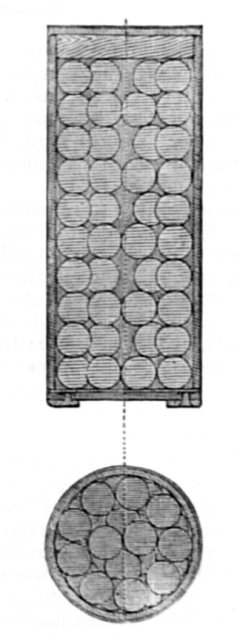
Shrapnel was used against scattered troops and skirmishers in open, fairly level ground, beyond the effective range of case. It was considered to be merely case adapted to long ranges. Although the shell could be fired to 3200 m (3500 yds) at 11deg 27min elevation, the time fuze was effective only to 9 seconds which meant a shrapnel range of only 2 650 m (2 900 yds). Variations in the powder used caused these ranges to change as the years went by.
According to the Gun Drill, case was to be used against infantry or cavalry at very close quarters. It consisted of a tin cylinder filled with 110 bullets of lead, hardened with antimony, packed in clay and sand. On being fired, the cylinder broke up in the bore and the bullets scattered at the muzzle. It was used when the situation was desperate and there was a possibility that the guns would be overrun. Case had a spread of about 45deg with the density of bullets greatest in the centre. This spread gave a lateral coverage of about 115 m (125 yds) at 137 m (150 yds), but thereafter bullets on the fringes fell off sharply in velocity. Coverage was about 27 m (30 yds) at 320 m (350 yds) which was the maximum effective range.
As the overrunning of a gun position was not considered to be a common occurrence, only four rounds per gun were carried. These were carried in the axletree boxes on the gun. There appears to have been a greater requirement for case in colonial warfare conditions than the authorities envisaged. They, after all, would have been thinking primarily of European conditions when they decided on the split between the various types of ammunition.
In the Zulu War, certainly case was used frequently. At Ulundi for example, the gunners used all their case against an enemy who swept up to within thirty metres of the guns, and they then had to fire reversed shrapnel which had a similar effect. The defenders of Eshowe were equipped with 7 prs but they also experienced a shortage of case shot. It was noticed that Morton’s jam tins exactly fitted the bore and an order went out that, as soon as they were empty, the tins were to be given to the gunners for conversion into case shot!
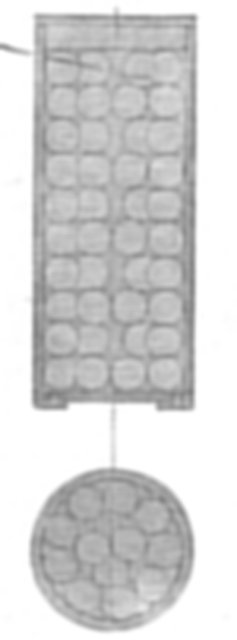
It should not be assumed that case-type ammunition is no longer in service. In Vietnam, the Americans supplied their 105 mm M 102 howitzers with anti-personnel flechette rounds for use against ‘human wave’ attacks. For practical purposes, these were the same as case, with flechettes, or darts, replacing the lead bullets.
Common shell was the forerunner of the modern high explosive shell. Originally, a common shell consisted simply of a hollow projectile containing gunpowder. There was no fuze and the shock of impact was sufficient to ignite the powder. The shock of firing more powerful guns caused this ignition to occur prematurely. The solution was to enclose the powder-bursting charge in a cloth bag to protect it from the rough inside of the shell, and to fit a fuze to deal with the problem of ignition.
The 9 pr RML common shell was a hollow projectile filled with 264 g (7,5 oz) of RLG powder. The interior of the shell was made smooth by lacquer to prevent premature explosions. When issued, the fuze hole was stopped by a papier mâché wad and fuze hole plug. This was removed and a fuze, either time or percussion but more normally the latter, inserted before firing. The bursting charge was ignited by means of the fuze, and this caused the shell casing to be scattered in fragments with considerable violence. Three pairs of metal studs on the shell exterior engaged with the rifling in the bore. The shell was painted black, except for the studs.

Common shell was used against troops at ranges considered long at that time, and against buildings and obstacles. Remember the comments referring to the effectiveness of artillery in the Franco-Prussian War. Maximun range was 3 200 m (3 500 yds). At the time, gunpowder was the only bursting charge suitable but it was not really effective. Gunpowder is a ‘low’ explosive. It is more suitable for lifting or heaving rather than shattering, as the velocity of its explosive wave is low. Its lethal effect is local, with the shell being burst into a few large fragments which are dispersed at a fairly low speed. ‘High’ explosives were known but the problem of firing them from a gun had not been solved, as the shock of discharge was liable to cause premature explosions.
In 1896, the British adopted a high explosive based on picric acid. This was known as lyddite. It was first used in action by 5 inch howitzers in the Sudan campaign of 1898. Other developments followed but these are beyond the scope of this article. Nowadays, gunpowder is used for ignition or in a fuze train, but seldom as a propellant or bursting charge.
Ammunition holdings per gun were as follows:
| Shrapnel | Common | Case | Time fuzes | Percussion Fuzes | Friction tubes | Cartridges | |
|---|---|---|---|---|---|---|---|
| Ongun | - | - | 4 | - | - | - | 4 |
| On limber | 24 | 12 | - | 60 | 48 | 100 | 36 |
| --- | --- | --- | --- | --- | --- | --- | |
| 24 | 12 | 4 | 60 | 48 | 100 | 40 | |
| Ammunition wagon: | |||||||
| On limber | 24 | 12 | - | 60 | 48 | 100 | 36 |
| On wagon body | 48 | 24 | - | - | - | - | 72 |
| --- | --- | --- | --- | --- | --- | --- | |
| 72 | 36 | - | 60 | 48 | 100 | 108 | |
| Total per gun | 96 | 48 | 4 | 120 | 96 | 200 | 148 |
| Empty | Bursting charge | Total | |
|---|---|---|---|
| Shrapnel | 4,4 kg (9 lb 12 oz) | 21 g (0,75 oz) | 4,45 kg (9 lb 12,75 oz) |
| Common | 3.9 kg (8 lb 9.5 oz) | 0,2 kg (7.5 oz) | 4,11 kg (9 lb 1 oz) |
| Case shot | 4,37 kg (9 lb 10,25 oz) |
| Length | Diameter (calibre) | |
|---|---|---|
| Shrapnel and common | 20,1 cm (7,93 in) | 7.6 cm (3 in) |
| Case shot | 18,8 cm (7,4 in) | 7,6 cm (3 in) |
In this article, certain criticisms have been levelled against the 9 pr’s ammunition, particularly in connection with its time fuze and the use of gunpowder. It must be remembered that these criticisms are made with the benefit of hindsight. For its day, the ammunition was effective and helped make the 9 pr a successful gun in the hands of the Royal Artillery.
Chown, The 9 pounder Muzzle-Loading Rifle.
Headlam, History of The Royal Artillery 1860-1914.
Hogg, Ian V., A History of Artillery.
Knollys H., Elements of Field Artillery 1877.
- List of Service Rifle Ordinance 1881.
Return to Journal Index OR Society's Home page
South African Military History Society / scribe@samilitaryhistory.org